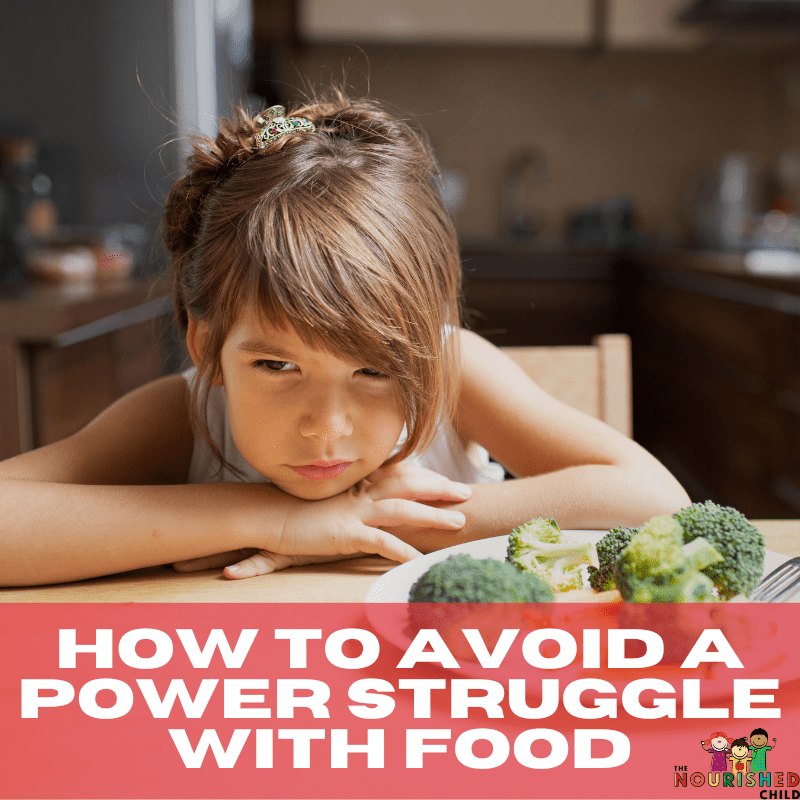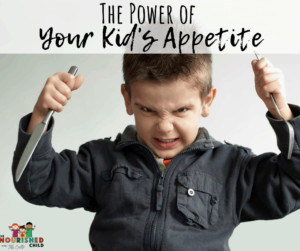How to Avoid a Power Struggle with Food
September 23, 2022
A power struggle over food disrupts family mealtime and may create negative eating behaviors in kids. Learn how to manage power struggles with strategies that reduce tension at the table.
Are you frustrated by the daily battles at meals?
Maybe you even feel you’ve lost the battle if you have a picky eater or a toddler who won’t eat.
I hear from many concerned parents who worry when their child refuses to eat.
Parents will do everything possible to ensure their kids get the nutrients needed to grow and develop into healthy adults.
Understandably, you might try to get your little one to eat when he refuses.
But if you’ve tried coercion and rewards, you know it doesn’t get a child to eat and only makes things more stressful and upsetting.
Hang in there.
Parents can shift the power dynamic with a few positive feeding strategies.
Let’s dive into the most common power struggle pitfalls for parents and what you can do instead to avoid struggles with food at the table.

What is a Power Struggle with Food?
Simply put, a power struggle over food is when a child refuses to eat a particular food or to eat at all.
A parent responds by trying to force him to eat using bribery, coercion, or threats.
These tactics create a negative feeding environment and, as many parents know, don’t have the intended result.
You may have experienced a power struggle or two with your little one and noticed if you reacted negatively, your child becomes even more stubborn and not likely to give in.
Parents are one of the biggest influences on a child’s eating behavior.
And not always in the way they intend.
A recent review found that restricting food, using food as a reward, or pressuring kids to eat doesn’t increase the likelihood that kids will eat healthy.
Instead, these tactics were correlated with unhealthy food consumption.
Kids develop eating behaviors like hiding or sneaking foods, emotional eating, or they can stay stuck with picky eating behaviors.
Some common examples of power struggles parents should avoid are:
- Pressure to take another bite or finish the meal
- Restricting foods or amounts or second helpings
- Hiding or sneaking foods (like vegetables!) into other foods
- Bribing with dessert for eating a certain food or amount
- Punishing a child by taking away TV, toys or other privileges
- Controlling food by hiding it or keeping it out of reach
Don’t feel bad if you’ve tried these.
Keep reading for positive alternatives that spare you and your child from mealtime stress.
How to Avoid Meal Table Battles
As a childhood nutrition expert, I’ve worked with many families to break the food power struggle.
My experience tells me that parents worry their child isn’t eating enough, is eating too much, or isn’t eating the right foods.
Instead of bringing all that worry with you to the table, trust that you have control over the food you offer and that your child will be okay even if all his meals and snacks aren’t going as well as you would like.
It’s the overall quality of a child’s diet that’s important.
So, don’t worry if your little one suddenly rejects a once favorite meal or refuses to try vegetables or new foods.
Keep mealtimes positive.
Here are some of my favorite strategies to avoid a power struggle with food:
Use Satter’s Division of Responsibility
Forcing a child to eat is a sure way to engage in a power struggle.
And it negatively affects how your child views food and experiences meals.
Instead of bribing, coercing, or threatening with punishment, the best way to end battles at the table is to establish what you as a parent are responsible for and what your child is in charge of during meals.
Ellyn Satter’s Division of Responsibility is the go-to strategy to help parents set mealtime boundaries.
Parents are responsible for what, where, and when a child eats.
What are kids responsible for?
Kids decide how much they eat and whether they eat.
Yes, that means letting go of some control at the table and allowing your child determine how much food to eat or whether they’re hungry.
Maybe you’re worried about what food your child chooses to eat. But, remember, you are still in charge of what food you offer your child.
Don’t Use Food as a Reward
It’s tempting to use dessert as a reward to get kids to eat.
Unfortunately, it doesn’t work.
Kids learn to see dessert as a means to an end and view healthy food as something they must endure to earn the reward.
Even if you get the result you were hoping for at one meal, this tactic creates a cycle with negative effects long term.
Using food rewards may increase emotional and picky eating as kids get older.
Additionally, external rewards can decrease internal motivation. And not only that, kids may lose their ability to eat intuitively by learning to ignore their internal hunger and fullness signals.
Offer Food Your Child Likes
It’s a good idea to offer at least one food you know your child likes and will eat at every meal.
Don’t worry. I’m not suggesting you make a separate main course.
Serve family-style meals and include an easy side dish your child likes, such as applesauce, crackers, or a cheese stick, along with the rest of the meal.
Or, make a meal or side dish that everyone, including your little one, will eat without push-back.
Instead of plating everyone’s food, serve the food in the center of the table and allow kids to take what and how much they want.
Your child won’t feel pressured to eat, which also takes the pressure off you.
It’s okay if your child only takes a side dish or two as long as he eats a balanced diet over the course of a week.
Establish a Feeding Schedule
Hungry kids who demand food between meals may be on their way to a power struggle.
Schedules help parents stay one step ahead and keep kids from getting too hungry.
Predictable feeding schedules reduce anxiety and tension in the house for both children and parents.
Kids know when to expect meals and snacks so they won’t ask for food throughout the day.
And, parents have time to prepare healthy snacks and meals. So, you don’t have to scramble to find a snack to feed a cranky and over-hungry child.
Feeding schedules aren’t used to restrict the amount of food your child eats.
Schedules create consistency and keep children from grazing between meals.
That way, kids come to the table hungry and ready to eat.
Final Thoughts on Avoiding a Power Struggle with Food
Many kids experience some degree of picky eating during childhood.
After all, kids have preferences, and pushing the boundaries of autonomy is a normal part of development.
You can expect a certain amount of resistance to new foods.
My best advice is to be patient and don’t react when your child refuses to eat.
You can change the dynamic around food. Start with a positive eating environment.
Encourage your child to follow his hunger and fullness signals.
Establish a meal and snack schedule, and continue to expose your child to healthy foods without pressuring them to eat.
Do you have a strategy that’s worked for your family?
Be sure to check out The Ultimate Guide to Feeding the Picky Eater!










